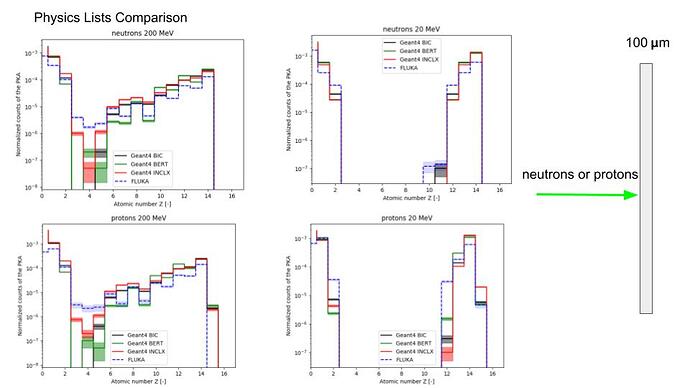Hello,
I was wondering what is the best model from BIC, INCLX, BERT (or is there another one?) to use when shooting protons and neutrons within the range of ~ 100 MeV on 100 mum silicon. The image I am including is showing the relative amount of generated elements (proton number Z on the x-axis) after shooting 200 MeV neutrons, 200 MeV protons, 20 MeV neutrons and 20 MeV protons perpendiculary to the Silicon sample. There is also comparison with FLUKA.
Thank you so much for the answer!
1 Like
I think the best way is to compare to experimental measurements if possible.
My two cents are the following and they are based on my expertise in health physics (it may not be applicable to your case). Usually QGSP_BIC_HP is adequate for dosimetry in hadrontherapy applications (proton energy below ~ 250 MeV). I saw studies where INCL is better for spallation problems. I see applications of BERT in radiation protection. Which type of application is this?
What we are doing is that we are using the QGSP_BIC(?)_HP to generate the energy spectra of the primary recoils (most frequently Silicon, due to either Coulomb Scattering or Elastic Scattering or Inelastic scattering: other fragments due to the spallation). Afterwards the primary recoils are fed into another simulation, that uses a custom physics list, that allows for the correct cascade of the subseqent silicon recoils. We are doing something very similar to this paper: https://ieeexplore.ieee.org/document/7582531.
Ultimately it is Non Ionizing Energy Loss, that we are insterested in. In particular we don’t want to use the Lindhard approximation, but look at the differences between spatial distribution of protons and neutrons Silicon recoils. From our leakage current measurements, we expect the protons to create more point defects and neutrons more cluster defects. To compare the spallation products with the measurement is not easily possible for us, the only thing we are able to measure is the final defect concentration of defects in Sillicon sample. The energies we are using at this point is 20-200 MeV, but at some point we would like to simulate 24 GeV. At this point we need most of all the ratio between the products created by the Coulomb scattering, Elastic collision and Inelastic to be as correct.
1 Like
